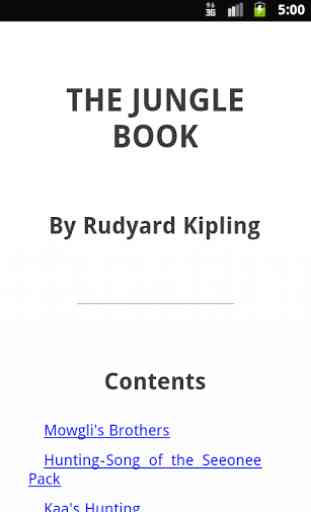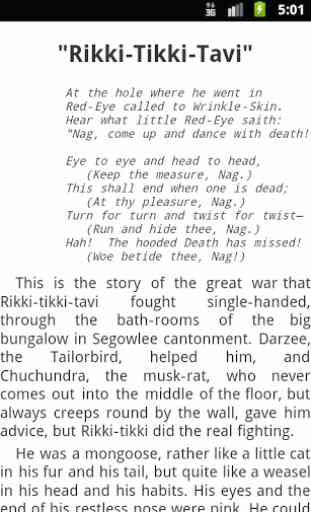The Jungle Book
The Jungle Book (1894) is a collection of stories by English Nobel laureate Rudyard Kipling. The stories were first published in magazines in 1893–94. The original publications contain illustrations, some by Rudyard's father, John Lockwood Kipling. Kipling was born in India and spent the first six years of his childhood there. After about ten years in England, he went back to India and worked there for about six-and-half years. These stories were written when Kipling lived in Vermont.The tales in the book are fables, using animals in an anthropomorphic manner to give moral lessons. The verses of The Law of the Jungle, for example, lay down rules for the safety of individuals, families and communities. Kipling put in them nearly everything he knew or "heard or dreamed about the Indian jungle." Other readers have interpreted the work as allegories of the politics and society of the time. The best-known of them are the three stories revolving around the adventures of an abandoned "man cub" Mowgli who is raised by wolves in the Indian jungle. The most famous of the other stories are probably "Rikki-Tikki-Tavi", the story of a heroic mongoose, and "Toomai of the Elephants", the tale of a young elephant-handler. As with much of Kipling's work, each of the stories is preceded by a piece of verse, and succeeded by another.The Jungle Book, because of its moral tone, came to be used as a motivational book by the Cub Scouts, a junior element of the Scouting movement. Akela, the head wolf in The Jungle Book, has become a senior figure in the movement, the name being traditionally adopted by the leader of each Cub Scout pack.You need Alphonso EBook Viewer to view this EBook. You will be prompted to download it for FREE when you open EBook. You can also download it from Google Play at http://bit.ly/EBookViewerVisit Blog: http://bit.ly/AlphonsoBlogEBooks Catalog: http://bit.ly/EBookCatalogEBook Blog: http://alphonsosofttech.blogspot.com/2013/05/the-jungle-book-by-rudyard-kipling.html
The tales in the book are fables, using animals in an anthropomorphic manner to give moral lessons. The verses of The Law of the Jungle, for example, lay down rules for the safety of individuals, families and communities. Kipling put in them nearly everything he knew or "heard or dreamed about the Indian jungle." Other readers have interpreted the work as allegories of the politics and society of the time. The best-known of them are the three stories revolving around the adventures of an abandoned "man cub" Mowgli who is raised by wolves in the Indian jungle. The most famous of the other stories are probably "Rikki-Tikki-Tavi", the story of a heroic mongoose, and "Toomai of the Elephants", the tale of a young elephant-handler. As with much of Kipling's work, each of the stories is preceded by a piece of verse, and succeeded by another.
The Jungle Book, because of its moral tone, came to be used as a motivational book by the Cub Scouts, a junior element of the Scouting movement. Akela, the head wolf in The Jungle Book, has become a senior figure in the movement, the name being traditionally adopted by the leader of each Cub Scout pack.
You need Alphonso EBook Viewer to view this EBook. You will be prompted to download it for FREE when you open EBook. You can also download it from Google Play at http://bit.ly/EBookViewer
Visit Blog: http://bit.ly/AlphonsoBlogEBooks Catalog: http://bit.ly/EBookCatalog
EBook Blog: http://alphonsosofttech.blogspot.com/2013/05/the-jungle-book-by-rudyard-kipling.html
By Rudyard Kipling
The tales in the book are fables, using animals in an anthropomorphic manner to give moral lessons. The verses of The Law of the Jungle, for example, lay down rules for the safety of individuals, families and communities. Kipling put in them nearly everything he knew or "heard or dreamed about the Indian jungle." Other readers have interpreted the work as allegories of the politics and society of the time. The best-known of them are the three stories revolving around the adventures of an abandoned "man cub" Mowgli who is raised by wolves in the Indian jungle. The most famous of the other stories are probably "Rikki-Tikki-Tavi", the story of a heroic mongoose, and "Toomai of the Elephants", the tale of a young elephant-handler. As with much of Kipling's work, each of the stories is preceded by a piece of verse, and succeeded by another.
The Jungle Book, because of its moral tone, came to be used as a motivational book by the Cub Scouts, a junior element of the Scouting movement. Akela, the head wolf in The Jungle Book, has become a senior figure in the movement, the name being traditionally adopted by the leader of each Cub Scout pack.
You need Alphonso EBook Viewer to view this EBook. You will be prompted to download it for FREE when you open EBook. You can also download it from Google Play at http://bit.ly/EBookViewer
Visit Blog: http://bit.ly/AlphonsoBlogEBooks Catalog: http://bit.ly/EBookCatalog
EBook Blog: http://alphonsosofttech.blogspot.com/2013/05/the-jungle-book-by-rudyard-kipling.html
By Rudyard Kipling
Category : Books & Reference

Related searches
Reviews (3)
Nit. C.
Jul 26, 2013
Excellent books if there were more programming boooks it would look pretty nice Can't comment on these books
Des. M.
Dec 30, 2013
I love reading!



The main book app is not there ..but previously I used this awesome alphonso book app. It's so good